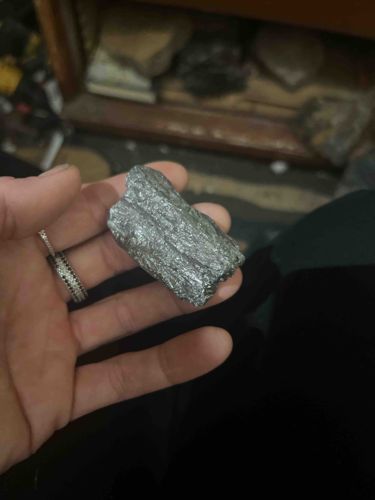
Metallic Mineral Sample (Possibly Antimony or Bismuth)
The item appears to be a raw mineral sample, likely a metallic element or a sulfide mineral, held within the palm of a hand for scale. It exhibits a distinct silvery-gray color with a strong metallic luster. The piece is irregularly shaped, roughly rectangular but with jagged edges and a rough, crystalline fracture surface. Its approximate size can be estimated as a few inches in length, fitting comfortably within the average human hand. The most prominent physical characteristic is its highly lamellar or foliated structure, with clear, parallel striations and cleavage planes visible across its surface. This suggests a brittle yet crystalline nature. There are no discernible manufacturing details such as maker's marks or signatures, as it appears to be a natural specimen. The visible condition is raw and unrefined, showing no signs of polishing or artificial alteration. There are no apparent damages, repairs, or significant wear beyond what would be expected from a natural mineral specimen. The material seems dense and heavy based on its metallic appearance. Without further analytical testing, it is difficult to precisely identify the mineral, but its appearance is consistent with elements like antimony, bismuth, or certain metallic sulfides like galena or stibnite, known for their bright metallic luster and often lamellar or acicular crystal habits. The specimen does not appear to be an artifact, rather a geological sample. The quality indicators point to a naturally occurring, high-grade mineral or metallic element sample, valued for its natural formation and characteristic crystal structure.
AI-Generated Appraisal Disclaimer
Estimated Value
$40-80
Basic Information
Category
Mineral Specimen
Appraised On
December 8, 2025
Estimated Value
$40-80
Item Description
The item appears to be a raw mineral sample, likely a metallic element or a sulfide mineral, held within the palm of a hand for scale. It exhibits a distinct silvery-gray color with a strong metallic luster. The piece is irregularly shaped, roughly rectangular but with jagged edges and a rough, crystalline fracture surface. Its approximate size can be estimated as a few inches in length, fitting comfortably within the average human hand. The most prominent physical characteristic is its highly lamellar or foliated structure, with clear, parallel striations and cleavage planes visible across its surface. This suggests a brittle yet crystalline nature. There are no discernible manufacturing details such as maker's marks or signatures, as it appears to be a natural specimen. The visible condition is raw and unrefined, showing no signs of polishing or artificial alteration. There are no apparent damages, repairs, or significant wear beyond what would be expected from a natural mineral specimen. The material seems dense and heavy based on its metallic appearance. Without further analytical testing, it is difficult to precisely identify the mineral, but its appearance is consistent with elements like antimony, bismuth, or certain metallic sulfides like galena or stibnite, known for their bright metallic luster and often lamellar or acicular crystal habits. The specimen does not appear to be an artifact, rather a geological sample. The quality indicators point to a naturally occurring, high-grade mineral or metallic element sample, valued for its natural formation and characteristic crystal structure.
Get Your Items Appraised
Instant estimates of your treasures with AI-powered instant appraisals